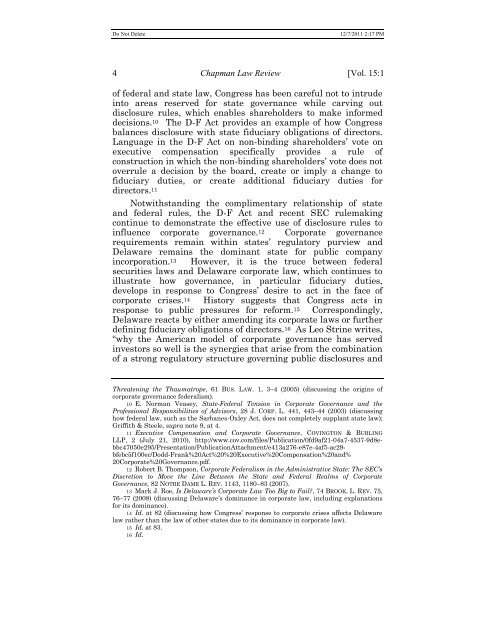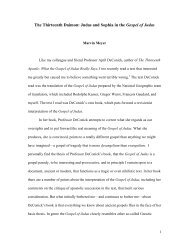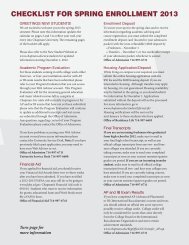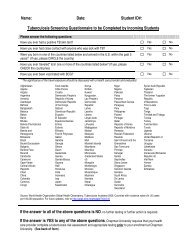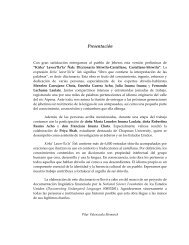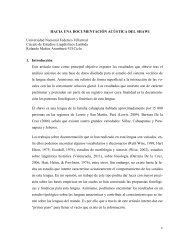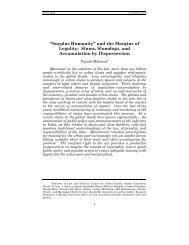Chapman Law Review - Chapman University
Chapman Law Review - Chapman University
Chapman Law Review - Chapman University
Create successful ePaper yourself
Turn your PDF publications into a flip-book with our unique Google optimized e-Paper software.
Do Not Delete 12/7/2011 2:17 PM<br />
4 <strong>Chapman</strong> <strong>Law</strong> <strong>Review</strong> [Vol. 15:1<br />
of federal and state law, Congress has been careful not to intrude<br />
into areas reserved for state governance while carving out<br />
disclosure rules, which enables shareholders to make informed<br />
decisions. 10 The D-F Act provides an example of how Congress<br />
balances disclosure with state fiduciary obligations of directors.<br />
Language in the D-F Act on non-binding shareholders‘ vote on<br />
executive compensation specifically provides a rule of<br />
construction in which the non-binding shareholders‘ vote does not<br />
overrule a decision by the board, create or imply a change to<br />
fiduciary duties, or create additional fiduciary duties for<br />
directors. 11<br />
Notwithstanding the complimentary relationship of state<br />
and federal rules, the D-F Act and recent SEC rulemaking<br />
continue to demonstrate the effective use of disclosure rules to<br />
influence corporate governance. 12 Corporate governance<br />
requirements remain within states‘ regulatory purview and<br />
Delaware remains the dominant state for public company<br />
incorporation. 13 However, it is the truce between federal<br />
securities laws and Delaware corporate law, which continues to<br />
illustrate how governance, in particular fiduciary duties,<br />
develops in response to Congress‘ desire to act in the face of<br />
corporate crises. 14 History suggests that Congress acts in<br />
response to public pressures for reform. 15 Correspondingly,<br />
Delaware reacts by either amending its corporate laws or further<br />
defining fiduciary obligations of directors. 16 As Leo Strine writes,<br />
―why the American model of corporate governance has served<br />
investors so well is the synergies that arise from the combination<br />
of a strong regulatory structure governing public disclosures and<br />
Threatening the Thaumatrope, 61 BUS. LAW. 1, 3–4 (2005) (discussing the origins of<br />
corporate governance federalism).<br />
10 E. Norman Veasey, State-Federal Tension in Corporate Governance and the<br />
Professional Responsibilities of Advisors, 28 J. CORP. L. 441, 443–44 (2003) (discussing<br />
how federal law, such as the Sarbanes-Oxley Act, does not completely supplant state law);<br />
Griffith & Steele, supra note 9, at 4.<br />
11 Executive Compensation and Corporate Governance, COVINGTON & BURLING<br />
LLP, 2 (July 21, 2010), http://www.cov.com/files/Publication/0fd9af21-04a7-4537-9d8ebbc47050e295/Presentation/PublicationAttachment/e413a276-e87e-4af5-ac29bfebc5f100ec/Dodd-Frank%20Act%20%20Executive%20Compensation%20and%<br />
20Corporate%20Governance.pdf.<br />
12 Robert B. Thompson, Corporate Federalism in the Administrative State: The SEC’s<br />
Discretion to Move the Line Between the State and Federal Realms of Corporate<br />
Governance, 82 NOTRE DAME L. REV. 1143, 1180–83 (2007).<br />
13 Mark J. Roe, Is Delaware’s Corporate <strong>Law</strong> Too Big to Fail?, 74 BROOK. L. REV. 75,<br />
76–77 (2008) (discussing Delaware‘s dominance in corporate law, including explanations<br />
for its dominance).<br />
14 Id. at 82 (discussing how Congress‘ response to corporate crises affects Delaware<br />
law rather than the law of other states due to its dominance in corporate law).<br />
15 Id. at 83.<br />
16 Id.


